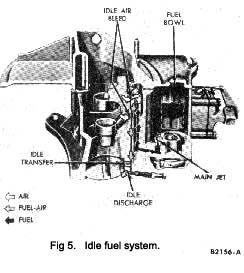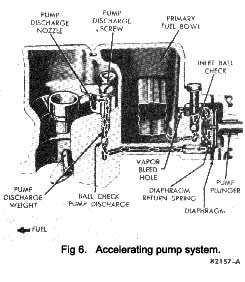During the warm-up period, if the engine should reach the stall point due to a lean mixture, manifold vacuum will drop considerably. The tension of the thermostatic spring then overcomes the lowered vacuum acting on the choke piston, and the choke plate will be moved toward the closed position, providing a richer mixture to help prevent stalling.
The linkage between the choke lever and the throttle shaft is designed so that the choke plate will partially open when the accelerator pedal is fully depressed. This permits unloading of a flooded engine.
Idle Fuel System
The difference in pressure between the fuel bowl and the idle discharge port forces fuel through the idle fuel system. Fuel flows from the fuel bowl through the main Jet and into the bottom of the main well (Fig. 5).
From the main well, the fuel flows up through the idle tube and through a short diagonal passage in the booster venturi assembly into the idle passage in the main body. A calibrated restriction, at the upper tip of the idle tube, meters the flow of fuel.
Air enters the idle system from the air bleed which is located directly above the idle tube. The air bleed also acts as a vent to prevent siphoning off at Idle or high speeds outlets when the engine is stopped. Additional air is bled into the system through an air bleed located at the bottom of the diagonal passage in the booster venturi where the fuel enters the idle passage in the main body. Fuel flows down the idle passage in the main body past three idle transfer holes. The idle transfer holes act as
|
additional air bleeds at idling speed. The fuel then flows past the pointed tip of the adjusting needle which controls the idle fuel discharge. From the adjusting needle chamber, the fuel flows through a short horizontal passage and is discharged below the throttle plates.
During off idle when the throttle plate is moved slightly past the idle transfer holes, each hole begins discharging fuel as it is exposed to manifold vacuum. As the throttle plate is opened still wider and engine speed Increases, the air flow through the carburettor is also increased. This creates a vacuum in the booster venturi strong enough to bring the main fuel system into operation. Fuel flow from the idle fuel system begins tapering off as the main fuel system begins discharging fuel.
Accelerating System
Upon accelerating, the air flow through the carburettor responds almost immediately to the increased throttle opening. There is, however, a brief interval before the fuel, which is heavier than air, can gain speed and maintain the desired balance of fuel and air. During this interval, the accelerating system (Fig. 6) supplies fuel until the other systems can once again provide the proper mixture. When the throttle is closed, the diaphragm return spring forces the diaphragm toward the cover, drawing fuel into the chamber through the inlet. The inlet has a ball check which opens to admit fuel from the fuel bowl and closes when the accelerating pump is operated to prevent a reverse flow. A discharge weight and ball check prevents air from entering when fuel is drawn into the chamber.
|
 **
**

